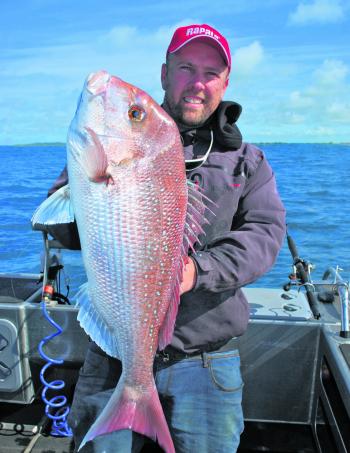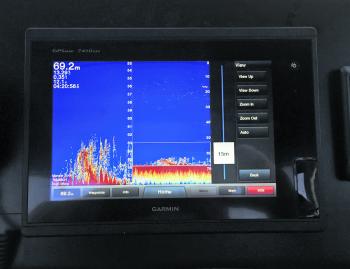Snapper are an important recreational target species across southern Australia. They’re found in a diverse range of habitats. With snapper season in full swing, it’s a perfect time to reflect on the fishery we have on the southwest coast of Victoria, and share my favourite technique for snapper on the coast this time of the year.
The spring months of the year have always been one of the best times to target larger snapper along this part of the coast. Usually during October and November, larger fish targeted in the bays and inlets in other parts of the state, turn up in close to shore and are picked up as by-catch by anglers fishing for smaller pinkie snapper, gummy sharks and flathead. The schools of larger fish are usually mobile at this time of year and can be caught in one spot on one day, but then disappear to go somewhere else the next day.
Most of the snapper fishery in the southwest is based on pinkie snapper, from just legal size to around 3kg. During the spring months, specimens around the magical 10kg mark are a possibility. In some locations, the larger fish can be caught all year round. Generally, snapper along this part of the coast make a migration to deeper water in the winter months, as the water temperature drops in late autumn, and are often captured in depths from 50-120m.
As the water starts to warm inshore in spring, they move in and are easier to target from smaller vessels, in depths of 10-45m. You don’t have to travel far from the coast. Snapper become more abundant on the surf beaches, this time of year. The Lee Breakwater at Portland is another land-based location that consistently produces larger fish during the late spring. Each season, anglers encounter fish in excess of 10kg.
There are two ways to approach your snapper fishing from the boat right now – anchor up and set a berley trail to bring the fish to you, or drift with a drogue to control your drift speed. Anchor and berley is a good technique for fishing known snapper haunts, when fishing over hard reef bottom or when the wind is too strong to drift correctly. For most of my fishing, I prefer to drift if the weather conditions are suitable. This has had many benefits over the years – it’s led to more consistent catches of larger fish and by-catches of other tasty bottom species.
Anchoring and berleying has the ever-present threat of bringing unwatered species to the boat, such as barracouta and sevengill sharks, which are simply tackle wrecking machines. Often, seals will come and hang around if they think there’s something on the menu. Throw in the cost of berley and it’s an expensive day of fishing.
Covering the underwater terrain by drifting allows you to search the bottom and find the fish, which are ultimately always on the move. Using this technique, I’ve found some of the best fishing spots I’ve ever fished. Without the drifting technique, I probably wouldn’t have known they were there! A drogue is the best way to control the drift of your boat and there are plenty of different types on the market.
Some anglers prefer one large parachute type drogue, while others prefer to use two units, one off each side of the transom, to help keep the boat straight and maximize the number of rods that can be fished. This technique works well with up to four rods on the drift fished from snapper racks, with limited chances of tangling. I usually only use the drogues when there is over five knots of breeze, below this level I usually don’t use a drogue at all.
Keep an eye on your GPS to determine the speed you’re drifting at. For optimal fishing you need to make sure that you don’t drift any more than around 2km/hr. This will give you time to cover the water and give the fish every opportunity to find the baits. Usually, the time to stop drifting is when there are whitecaps forming at the transom. This signifies that I’m drifting around 3km/hr or more. The number of bites drops considerably too and you’ll notice that even fish like snapper will stop biting. Everybody’s boat catches the wind differently, so you need to find a drogue size to suit your needs in the conditions.
By covering a lot of ground, the potential of picking up other species is also amplified. I’ve caught plenty of good gummy and school sharks, tiger flathead, blue morwong, squid and other varieties of shark on the drift. Each time I hook a fish, I religiously enter the mark into the GPS. This has provided invaluable information to me over the years, and I’ve been able to identify a range of areas that continue to produce fish on a regular basis, as a result.
The amount of lead you use is also important. As always, the minimum for the situation is encouraged. In 30-50m, I use 6oz, but will go down to 4oz if it’s reasonably calm. When the wind is blowing, and the drift is over 1.5km/hr, I’ll go up to 8 or even 12oz. The most important thing to remember is that your line sits on the bottom with an angle that’s straight down where possible. If you keep letting line out to try and stay on the bottom, you need to upsize your lead. If the angle of your line is significant, this will lend your rig to snagging and the loss of gear – somewhat frustrating as your standard 6oz lead sinkers cost around $4 each.
Depending on the underwater terrain, you may need to customise your rigs. I fish over a broken rubble bottom, but if you’re fishing on heavy bottom you might want a breakaway light leader to attach your sinker to. You won’t lose the lot when the bottom is hard, but you need to ensure your baits are near the bottom. Use a single hook rig – there’s really no need for multi-hook rigs. If you put your bait on using bait elastic, it shouldn’t fall off or require constant checking anyway.
Circle hooks are undoubtedly the best hooks to use when drifting for snapper. You can set your rods in the snapper racks and leave the ratchets on, then wait for the line to run. It’s very simple fishing – more than 90% of the time the fish will hook themselves quickly. I prefer circles in sizes from 5/0 to 7/0. Pre-tied rigs like the Black Magic Snapper Snatchers in these sizes are ideal, but I prefer to make my own as single hook rigs, with either 60 or 80lb droppers.
There are many baits that work well on snapper. Frozen pilchards always seem to produce fish, but I use fresh baits such as squid, octopus or fish fillet baits – salmon, mackerel or trevally. It’s important to rig your bait correctly. When you’re presenting your bait, use a fine bait elastic. This will help to keep your bait on the hook longer, especially when the smaller pickers are around. This will also allow you to firmly attach your bait to the circle hook. Simply bind your bait at one end with bait cotton, and then put the hook through, ensuring there’s plenty of barb penetration.
Most of the fish are caught in water depths of 10-50m, so a reel capable of holding 250m of braid will be more than enough to hold good fish. A 10-15kg overhead outfit is ideal, and will be suitable landing large fish like gummy and school sharks, that you might pick up while drifting.
With a few tips, drifting for snapper is a simple, relaxing and effective way to target snapper. Even when they’re quiet, you can count on a catch of some tasty table species. If you’re chasing a snapper on the southwest coast this spring, get on the drift. You’ll never know what you might find!
1
During spring, the larger snapper come closer to shore on the southwest coast.
2
Flatties and gummy sharks can be common by-catches when fishing for snapper.
3
Marking your GPS after hook-ups can help you locate consistent fish-producing spots. Keep an eye on your GPS to monitor your drift speed.
4
The amount of lead you use is important – the minimum for the situation is encouraged.
5
Cracker snapper up to 10kg can be picked up in these warmer months.
6
With a few tips, drifting for snapper can be easy, relaxing and effective.
7
Keeping your line straight can avoid snags.
8
Berlerying can attract unwanted extras like barracouta or sevengill sharks.
Reads: 5549











